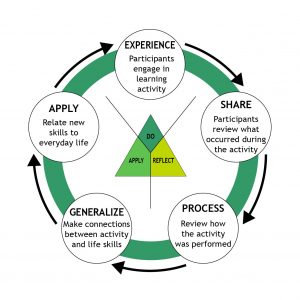Home » Resources » Volunteer Resources » 4-H Foundations » Experiential Learning Model
Experiential Learning Model
For communicative accommodations in languages other than English, please contact oaic@extension.wisc.edu.
Para pedir adecuaciones para la comunicación en un idioma distinto al inglés, favor de comunicarse con: oaic@extension.wisc.edu.
Most educators and experienced 4-H volunteers will tell you that the best way to engage youth in learning is to create experiential learning opportunities, allowing youth to explore and discover rather than listen to lectures or read information. In fact, the science behind how we learn supports this theory. We are more likely to remember things that we do or teach other people rather than information that we read or hear.
It is also vital as we support positive development in youth that we help participants learn life skills, growing in each of the four parts of the Clover: Head, Heart, Hands, and Health. How do we teach these skills using research supported, youth-centered, active learning? We use the Experiential Learning Model!
The Experiential Learning Model is a teaching method that focuses on creating experiences for youth and taking time to process those experiences as a group. The reflection portion of learning encourages young people to apply new life skills in different situations. It shifts the experience from a fun activity to long-term learning and application. There are five steps in the Experiential Learning Model:

DO
1) Experience: Participants engage in learning activity
REFLECT (skill focused)
2) Share: Participants review what occurred during the activity
3) Process: Review how the activity was performed
APPLY (activity focused)
4) Generalize: Make connections between activity and life skills
5) Apply: Relate new skills to everyday life
Aside from being a strong, research-supported teaching method, there are many benefits for both the volunteers and the youth in using the Experiential Learning Model.
For volunteers
- Steps 2-5 of the model help volunteers check in with youth about how much they have learned. If participants can talk about using the skills in other settings, it is a great indication that they understand the concept.
- The volunteer gets to act as a coach instead of a lecturer, which is more comfortable for many people.
- The process is cooperative and encourages volunteers to learn alongside youth.
For youth
- The circular nature of the model means that discussions can lead to more experiences that use the same life skills. This allows youth to build on prior knowledge.
- Youth are more likely to be involved in the planning and evaluation process with the Experiential Learning Model. It lets them use and practice life skills in all parts of the learning process, which is a core tenet of the 4-H philosophy.
- Youth learn from each other rather than relying solely on adults. This encourages teamwork, especially as they share information with each other and evaluate the activity.
- Youth have the opportunity to take responsibility for their own learning. They are involved with every step of the process in order to be successful.
- Finally, the reflection portion of this method relates the skills learned to real life, a great motivator when young people learn new things.
Learn more with the Experiential Learning Model handout.
This page is optimized for printing




